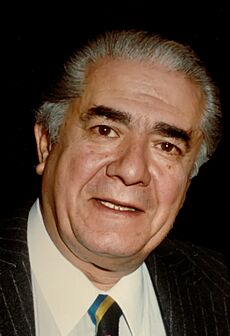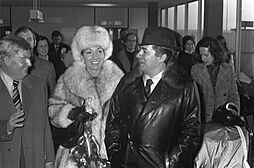Giuseppe Di Stefano facts for kids
Giuseppe Di Stefano (born July 24, 1921 – died March 3, 2008) was a famous Italian opera singer. He was a tenor, which is a type of male singing voice. He sang professionally from the mid-1940s until the early 1990s.
Friends and fans often called him "Pippo." He was known as the "Golden Voice" or "The Most Beautiful Voice." Many people saw him as the true successor to another great tenor, Beniamino Gigli.
Even famous singers like Luciano Pavarotti looked up to Di Stefano. Pavarotti once said that Di Stefano was his idol. He described Di Stefano's voice as "solar" and "the most incredible, open voice you could hear." Di Stefano also inspired José Carreras, another well-known tenor. Giuseppe Di Stefano passed away in 2008 after a serious incident at his home.
Contents
Early Life and Music Training
Giuseppe Di Stefano was born in 1921 in Motta Sant'Anastasia. This is a small village near Catania, in Sicily, Italy. When he was six, his family moved to Milan.
He was the only son of a father who was a police officer turned shoemaker. His mother was a dressmaker. Di Stefano went to a Jesuit school and even thought about becoming a priest for a short time.
When he was 16, he sang loudly after losing a card game. His friend heard him and told him he should train his voice. Two years later, he started serious singing lessons. His teachers were the baritones Luigi Montesanto and Mariano Stabile. Stabile taught him how important it was to sing words clearly, which Di Stefano always remembered.
Singing During World War II
World War II started during Di Stefano's early career. He had to join the Italian army. He often sang to entertain the soldiers. His commanding officer thought he was not a very good soldier. So, he decided Di Stefano could serve his country better by leaving the army to sing.
He performed using the name Nino Florio. After Italy was defeated in the war, he went to Switzerland. He was held there for a while, but then he was allowed to sing on Lausanne Radio. This is where he made his first recordings. These recordings showed he had a beautiful tenor voice and a strong personality. He recorded many songs in his native Sicilian language. These records helped people outside Italy notice him in the late 1940s.
Amazing Opera Career
Giuseppe Di Stefano started his career as a lyric tenor. He was famous for roles like Nemorino in Donizetti's L'elisir d'amore. He also played Alfredo in Verdi's La traviata.
He first performed in New York at the Metropolitan Opera in February 1948. He sang the role of the Duke of Mantua in Verdi's Rigoletto. After he performed in Manon a month later, a music magazine called Musical America wrote about him. They said Di Stefano had a "rich velvety sound" that had not been heard since the time of Beniamino Gigli. He continued to sing regularly in New York for many years.
In 1957, Di Stefano made his first appearance in Britain at the Edinburgh Festival. He sang Nemorino in L'elisir d'amore. In 1961, he performed at the Royal Opera House, Covent Garden, as Cavaradossi in Tosca.
His Special Singing Style
People admired Di Stefano for many reasons. He had excellent diction, meaning he sang words very clearly. His voice had a unique sound, called a timbre, which was warm and rich. He sang with great passion. People especially loved how sweetly he could sing very softly, known as a pianissimo.
When he first sang on a Metropolitan Opera radio show in Faust, he did something amazing. He sang a high C note loudly, then made it incredibly soft. Sir Rudolf Bing, a famous opera manager, said he would never forget "the beauty of that sound."
During his time as a world-famous singer, Di Stefano won a gold Orfeo. This is an important Italian music award.
Working with Maria Callas
In 1953, Walter Legge from EMI (a record company) wanted a tenor to record popular Italian operas. He chose Di Stefano to record with the legendary Maria Callas.
One of their most famous recordings was the 1953 studio version of Tosca. Many people consider it one of the greatest opera recordings ever. Di Stefano and Callas also performed together often on stage. They sang together from 1951 until the end of 1957. Their last opera together was Un ballo in maschera at La Scala.
He sang Alfredo in a famous production of La traviata in 1955. He also sang Edgardo to Callas's Lucia in Lucia di Lammermoor. These performances were led by Herbert von Karajan in Milan, Berlin, and Vienna.
Some people, like Rudolf Bing, thought Di Stefano's busy social life caused his voice to decline. However, Di Stefano himself said that allergies to certain fabrics damaged his vocal cords.
In 1973, Di Stefano and Maria Callas went on a concert tour together. It ended in 1974. Critics noted that Maria Callas's voice was not as strong as before. But audiences were still very excited to see them. There were even rumors that the two singers had a brief romantic relationship during this time.
Di Stefano continued to sing successfully. His very last opera role was the Emperor in Turandot in July 1992.
Private Life
In 1949, Giuseppe Di Stefano married Maria Girolami in New York City. She was a music student. They had three children together. They separated in 1976.
In 1977, he started a new relationship with Monika Curth. She was an operetta singer from Hamburg, Germany. They got married in 1993.
His last public appearance was on October 24, 2004. He received an award in Oderzo, Italy.
On December 3, 2004, he was seriously injured during an incident at his home in Diani Beach, Kenya. He was hospitalized in Mombasa. His condition was more serious than it first seemed. After several operations, he fell into a coma on December 7. On December 23, he was moved to a hospital in Milan, Italy. He eventually woke up from the coma, but his health never fully recovered. He passed away at his home in Santa Maria Hoè, near Milan, on March 3, 2008. He was 86 years old.
Vocal and Singing Style
Di Stefano was known as a lyric tenor. He had a soft voice with a unique, warm, and rich sound. Especially in his early years, his voice was very expressive. People admired his clear diction, passionate way of singing, and captivating performances. He was also famous for his beautiful, light pianissimo notes and vocal shades.
Unlike some singers who focused on perfect precision, Di Stefano had a natural musical talent. His singing style was generous, instinctive, and very good at connecting with the audience.
Di Stefano belonged to the tradition of lyric tenors in Italian and French opera. He gave memorable performances, especially in the first part of his career. These included roles in Rigoletto, La traviata, La bohème, The Pearl Fishers, Manon, and Faust. Later in his career, he took on more dramatic roles. These included parts in Tosca, La forza del destino, Turandot, Carmen, and even Pagliacci and Andrea Chénier.
Recordings with Maria Callas
Di Stefano and Maria Callas recorded many operas together for EMI. Here are some of the complete operas they recorded:
- Lucia di Lammermoor – 1953
- I puritani – 1953
- Cavalleria rusticana – 1953
- Tosca – 1953
- Pagliacci – 1954
- Rigoletto – 1955
- Il trovatore – 1956
- La bohème – 1956
- Un ballo in maschera – 1956
- Manon Lescaut – 1957
They also recorded some duets together in 1972. These were not officially released, but some unofficial versions appeared.
Other Important Recordings
Di Stefano also made many other recordings with other amazing singers.
- For EMI, he recorded Madama Butterfly with Victoria de los Ángeles in 1954. He also recorded La traviata with Antonietta Stella and Tito Gobbi in 1955.
- For Decca, he recorded L'elisir d'amore in 1955. He also recorded La Gioconda in 1957, La forza del destino in 1958, and Tosca in 1962.
- For Ricordi, he made a stereo recording of Lucia di Lammermoor in 1958. He sang with Renata Scotto and Ettore Bastianini.
- In 1995, a recording of La bohème from a 1959 performance was released. Di Stefano starred alongside Licia Albanese.
- In 1962, he recorded parts of Massenet's Manon with Anna Moffo.
- In 1951, Di Stefano sang in a performance of Verdi's Requiem at Carnegie Hall. This performance was conducted by Arturo Toscanini and later released as a recording by RCA.
Images for kids
See also
 In Spanish: Giuseppe Di Stefano para niños
In Spanish: Giuseppe Di Stefano para niños









